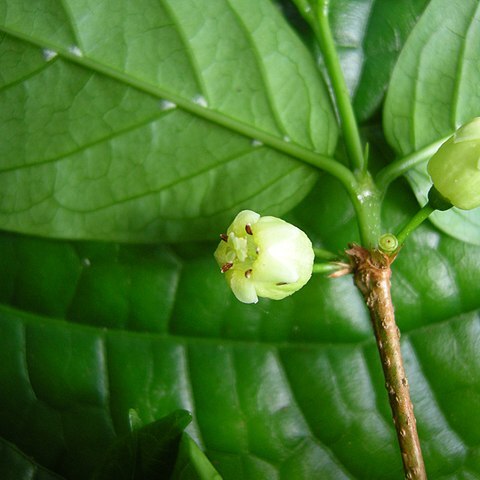Corolla obtuse, acute or conspicuously long-apiculate in bud; tube cylindrical, glabrous or pubescent outside, glabrous or hairy within for part or for most of the tube length, or corolla tube with a ring of deflexed hairs in the middle; lobes shorter than to longer than the tube, acute to very distinctly long apiculate, or with a filiform appendage.
Flowers axillary, solitary, or in 2–10(15)-flowered umbel-like cymes, mostly 5-merous, small, usually white, yellowish or greenish; peduncles and pedicels mostly well-developed; bracts and sometimes bracteoles present, small; sometimes inflorescence axes scarcely developed and flowers appearing fasciculate.
Leaves opposite, or occasionally in whorls of 3 particularly in some forms of R. celastroides, petiolate, often with domatia in axils of nerves beneath; stipules often ± persistent, connate at the base, oblong or triangular, villous within, ending in a mostly linear or subulate ± deciduous appendage.
Calyx tube ± subglobose; limb short, truncate or denticulate, distinctly lobed in a few species (mostly in distinctive subgenera), mostly persisting on the young fruit.
Pollen presenter coroniform, subglobose or occasionally cylindrical, sulcate beneath where in contact with anther cells, mostly distinctly 2–5-lobed at the apex.
Pyrenes narrowly ± reniform or boat-shaped, the notch usually about one third from the apex, the dehiscence line on a ± marked keel, often pitted.
Stamens slightly to distinctly exserted; anthers often mucronate to slightly appendaged, often papillate; filaments very short.
Fruit mostly globose, or asymmetrical and compressed if only 1–2 pyrenes developed, c. 10 mm in diameter, with 1–5 pyrenes.
Shrubs or small trees, occasionally somewhat scrambling; stems spiny in a few species, usually distinctly lenticellate.
Ovary mostly 3–5(6)-locular, but 2-locular in some species.
Style usually exserted, slightly swollen at the base.
Disk depressed, glabrous.

